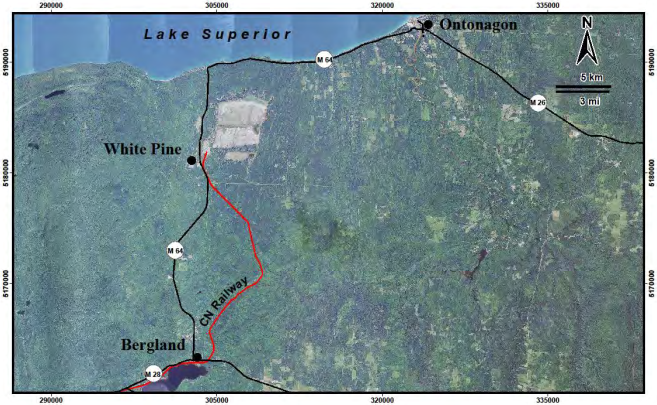 |
| Satellite |
 |
| Page 23 from Technical Report Figure 5.1 Transportation access to the historical White Pine Mine showing M-64 and the Canadian National Railway spur. |
On September 3, 1995, the White Pine Mine, which is owned by Copper Range Company, conducted the first of a planned series of explosive removal of existing pillars in their underground mining operations. The purpose of this operation is to evaluate the effectiveness of pillar rubbilization and roof collapse for planned in-situ leaching of the copper ore from the rock mass. This type of seismic source is unique in that a large, delay fired, explosive source was expected to be followed by collapse of the rock immediately above the explosion into the void created. Characterization of this type of mining source is of interest to the Comprehensive Test Ban Treaty (CTBT) R&D Seismic Program due to its unique properties. These include the controlled nature of the source in time, location, and magnitude, the fact that the source is located in an active region of underground mining, and that natural collapse of large portions of this mine have occurred in the recent past. The Mine operator is concerned with the characterization of the vibration induced by both the explosive and implosive components of the procedure and determination of the depth to which chimneying of the roof proceeded. This report will document: The reasons for conducting both the explosively induced collapse and the Los Alamos National Laboratory CTBT R&D Experimental Field Program experiment; The local and regional seismic, acoustic, and videographic data acquired; Analysis of the explosion/collapse seismic signal generated; Analysis and location of the aftershocks associated with the collapse; and Conclusions made concerning this type of mining explosion in relation to verification of a Comprehensive Test Ban Treaty. [ResearchGate]I remember that the study placed several seismographs around the site before the explosion.
The leaching is done with sulfuric-acid transported by railroad tank cars! And the EPA approved the leaching procedure with no public reviews. After the Chippewa Indians protested, the EPA agreed to review their decision. "Once the EPA looked closer, it raised enough questions that Inmet suspended its operations. In the face of legal battles over treaty rights, the company withdrew its mining-permit application the next spring."
No comments:
Post a Comment